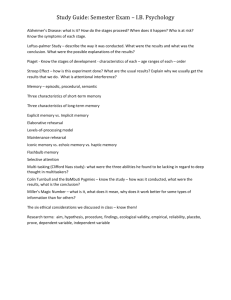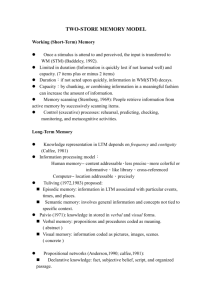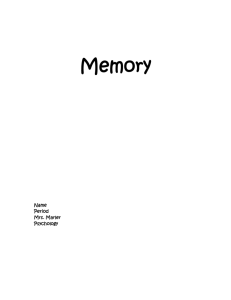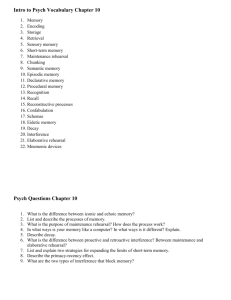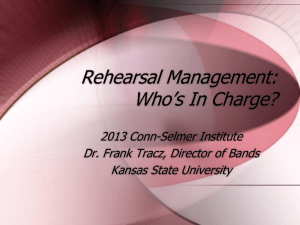5501-Ch Memory Major components of the human memory system
advertisement
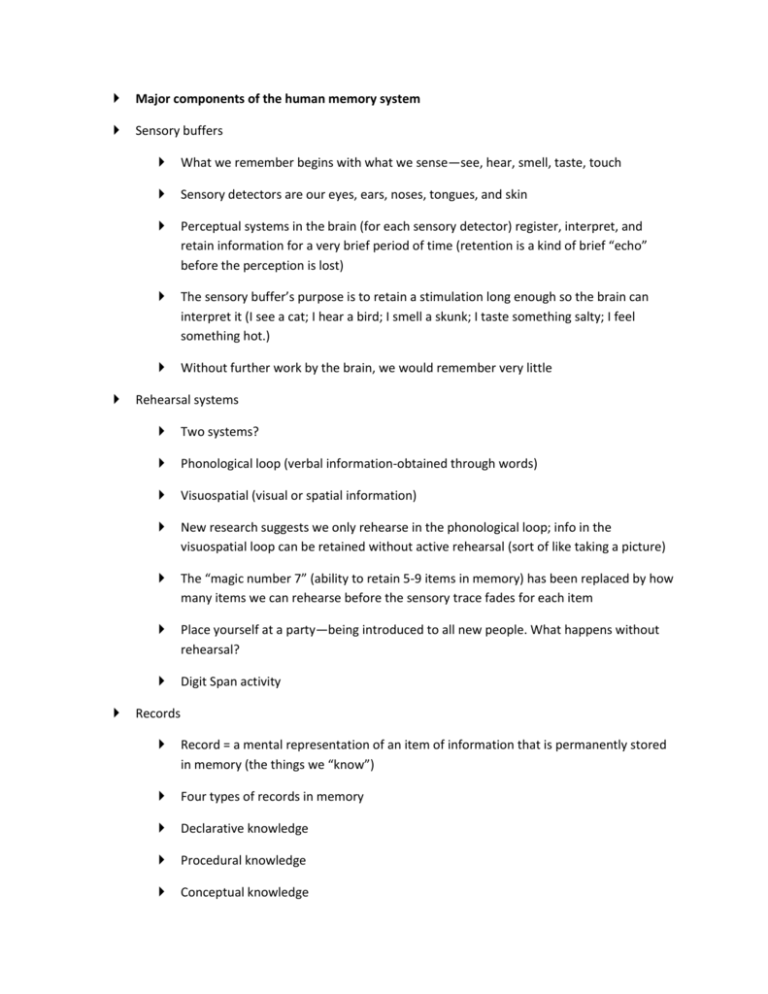
Major components of the human memory system Sensory buffers What we remember begins with what we sense—see, hear, smell, taste, touch Sensory detectors are our eyes, ears, noses, tongues, and skin Perceptual systems in the brain (for each sensory detector) register, interpret, and retain information for a very brief period of time (retention is a kind of brief “echo” before the perception is lost) The sensory buffer’s purpose is to retain a stimulation long enough so the brain can interpret it (I see a cat; I hear a bird; I smell a skunk; I taste something salty; I feel something hot.) Without further work by the brain, we would remember very little Rehearsal systems Two systems? Phonological loop (verbal information-obtained through words) Visuospatial (visual or spatial information) New research suggests we only rehearse in the phonological loop; info in the visuospatial loop can be retained without active rehearsal (sort of like taking a picture) The “magic number 7” (ability to retain 5-9 items in memory) has been replaced by how many items we can rehearse before the sensory trace fades for each item Place yourself at a party—being introduced to all new people. What happens without rehearsal? Digit Span activity Records Record = a mental representation of an item of information that is permanently stored in memory (the things we “know”) Four types of records in memory Declarative knowledge Procedural knowledge Conceptual knowledge Episodic knowledge Cues Things in the environment or items in a rehearsal system that are connected to records May come from the associative networks that go with declarative knowledge (e.g., What animal flies, makes nests and lays eggs? Remember our earlier associative network for bird?) May come from a specific rehearsal system we create (e.g., how do you remember the order of operations, the planets in order, or the notes on a musical staff?). Two main types of processes used by the memory system Forming permanent records (storage) Encoding Taking sensory information and transforming it into a permanent record Encoding is not photographic or complete (in most of us) Selective—only include certain aspects of an experience (think about the problem of getting five eyewitness accounts of the same accident in which each one has selectively remembered different aspects of the event) Interpretive—based on our orientation toward the information being recorded (In the above example, what impact on our memory would it be if one of the persons in the accident in a friend?) Rehearsal—process of repeating or re-experiencing a stimulus over and over Large body of evidence that supports the claim that repetition and practice determine the strength of a record Power Law of Learning—generally means that initial practice has greater returns with larger increments of increase in strength of the record than later practice Straightforward implication = teachers should do whatever they can to strengthen permanent records through practice(and I would add that immediate practice is very important) Key questions: What implications does the Power Law of Learning have for your instruction? What application to the concept of “transfer of skills” can you identify? Elaboration “Going beyond the information given” and “embellishing a raw experience with additional details” Skilled readers do this automatically as they take in information from the words on the page and make inferences about what they have read Every reader, in essence, “rewrites” the book as s/he reads This sometimes makes it difficult to determine what you actually read and what you inferred What elaborations did you make as you read this chapter? Encoding and elaborating Depth of processing Some researchers put the two concepts together to form this construct In this context, any experience can be encoded shallowly or deeply Deep processing would likely involve the building of conceptual knowledge, e.g.: Why 3 X 3 = 9 (because it represents 3 groups of three items) Why you use a 0 placeholder when multiplying two-digit times two-digit numbers Key question: How can teachers help students encode and elaborate information more deeply? Think out loud teaching strategy 54 X47 Why do you put a zero in the ones place before you multiply 7 X 5? Retrieving permanent records (retrieval) Getting information into memory isn’t the only step—you have to get it out if it is to do any good! Three processes: Recall-you try to retrieve information with the help of only a limited number of cues Recognition-you see, hear, smell, touch, or taste something and have the feeling that you have encountered this stored representation before; you then match it to the real thing in the world Inferential reconstruction-your cues cause you to retrieve only a few fragments of a more complete record and you use inference to build up a plausible story around the fragments that seems close to the original Important assumption about recall and recognition!! In either case (recall or recognition): The probability of remembering is a process of the strength of the association between cues and records!!!!!!! Why is this an important assumption? So what do you do to enhance students’ memory skills? STRATEGIES!!!!!!!! Strategies are approaches that students can use to help themselves remember bette They do this by exploiting the properties of memory we have discussed up to this point There are five types of strategies Rehearsal Repeating information over and over (“drill and practice”) Once thought to be the only way to increase the strength of a record Now know that: Repetition does not always increase the strength of a record (think of the student who drills and drills on multiplication facts but never can remember them) Some things can be learned in a single exposure Why can rehearsal work? Our minds are built to remember things we encounter again and again How should we use rehearsal? Distributed practice works better than cramming for long-term retention, but the crammer may do better if the last distributed practice was too long ago—Implications? Primacy and recency effects—things encountered first and last are usually remembered best—Implications? Organization Arranging to-be-remembered information into groups and subgroups or hierarchies of subgroups The groups become the retrieval cues—why? Two applications: Teachers need to provide information in an organized or grouped fashion (e.g., multiplication facts presented as the X1’s, X2’s, X5’s, etc.) Teachers need to encourage students to learn how to impose their own organizational strategies The problem for the teacher is to determine when to provide the organization and when to encourage the students to form their own organization of concepts Generation effect—older students remember better when they impose their own organizations Key questions: How can a teacher address the generation effect but ensure that those who are not developmentally ready be able to establish a useful organization of key information? Elaboration General term for imposing meaning of any kind on material Prototypical example of elaboration comes from research with paired associates learning (e.g., cat-ribbon) How would you try to connect these? Purpose is to create meaningful relations where no such relation exists Works as a strategy because: Creation of an elaborative encoding Generation effect-making up own images More naturally equipped to retain visual info more easily than verbal As we demonstrated earlier, it is possible to elaborate verbal information in such a way to make it easier to remember (story) Acronyms are another way to impose meaningful connections (http://www.delmarlearning.com/companions/content/1428336478/ti ps/CHAPTER6_tip_memory.pdf) Elaborate: create a story that uses all of the following words. Don’t write anything down. Jam Cartoon Envelope Farm New Jersey Cat Paperclip Book Mouse Basketball Coat Plant Light Date Plug Method of Loci Linking a familiar routine with a series of items you are trying to learn Take a list of facts and mentally “attach” them to a familiar route you take Take a list of ten facts; identify ten landmarks on your familiar route (church, favorite house, restaurant, etc.) Imagine each one of the facts “plastered” on each site Works because: Elaborative encoding Capacity to remember visual more easily than verbal Generation effect Imposed organization on the material Each landmark serves as a retrieval cue For a more complete description of how to use this strategy go to http://health.howstuffworks.com/how-to-improve-your-memory7.htm Keyword Especially useful with verbal material, such as new vocabulary (also learning math facts!) The meaning of a new word is associated with a picture that contains words that sound like the parts of the word E.g., caterwaul=a noisy fight Imagine two cats fighting and making loud noises on a wall http://www.k8accesscenter.org/training_resources/mnemonics_math.a sp Look at the list below for 10 seconds; try to remember as many as possible. Brush Notebook Paperclip Cow Horse Razor Soap Pencil Dog Telephone Bird Toothpaste Working memory Permanent memory RECORDS Record = a mental representation of an item of information that is permanently stored in memory (the things we “know”) Four types of records in memory Declarative knowledge - Declarative Memory “Knowing that” Propositional in nature (i.e., can be true or false) Behavioral studies suggest that declarative knowledge exists in the form of associative networks Central notion (e.g., bird), plus Associative facts people know in relationship to the central notion (can fly, lays eggs, etc.) Key Question: How can we use this idea of associative networks in declarative knowledge when trying to teach factual information? Math? Science? Reading? Graphic organizers-a tool to help build associative networks when teaching declarative knowledge flies eats worms, seeds, berries Bird makes nests Procedural knowledge lays eggs “Knowing how” The skills and habits you have formed These records help you remember how to do things like driving a car, cooking your favorite recipe, or (once formed) using the tools correctly in Elluminate (this one is directed at me!! ) Does not appear to be interconnected in a network Does appear to be associated to cues in the environment (seeing a plus sign in a math problem reminds me of the procedure for adding) Key question: How could you use the assertion that procedural knowledge appears to associated to cues in the environment to help students learn a new procedure? The “wall”—an environmental cue that can remind students that they must start adding from the right. Later, the “wall” is no longer needed because the visual stimulus of numbers lined up will be the reminder of the “wall.” 42 [] +78 [] 120 [] Conceptual knowledge “Knowing why” Student can give an accurate answer (that makes sense to him or her) of why declarative facts are true or why procedures work as they do Helps a student understand what is going on Example: Multiplication facts, manipulatives and chocolate chip cookies Key questions: What is a good way to determine whether a student has the conceptual knowledge you want him/her to have? Relationship to declarative and procedural knowledge? Relationship to transfer value? Episodic knowledge “Knowing when and where” Where you were when something happened to you (Can you remember where you were on 9/11?) When an event took place in your life (What month/year did you meet your significant other?) Has a personalized and historical quality (also called autobiographical memory) An important feature is the association between the knowledge and the source of the knowledge; connecting the two can actually help the retention (or forming of the record) Key question: How can you use your understanding of the nature of episodic knowledge to help students form important records? Records can be stored in two types of “codes” Visual—stored as a mental image or a nonverbal sequence of imagined actions When trying to remember where you put your glasses, you might try to visualize the last time you saw them This is a constant memory task for my husband! ) When trying to remember where I put my keys, I may go through a set of visual images of where I have been since I last had them! Verbal—stored as a factual proposition or a verbalized set of instructions “The teacher said that a noun is a person, place or thing” “To identify a verb I should 1) look for the noun, and 2) then figure out what the noun is doing (or being) Verbally coded messages can be coded into visually coded messages when language is interpreted into a mental image. Key Question: What important activity requires the skill of changing a record from verbal to visual coding? In what ways do you teach this skill? Two constructs that help explain why some things are remembered more easily than others Strength of the record-the degree to which it can be retrieved High-strength—well learned facts (name, address) Low-strength—facts and procedures not learned so well and hard to retrieve (the state capitals or algebra equations) The amount of practice affects the strength Key question: Why is this an important concept to every classroom? How is the practice of key facts/procedures being incorporated into your classrooms? Activation level—degree of availability High state of activation—conscious and available (easily remembered) Low state of activation—harder to retrieve Association between strength and record: high strength records are more easily activated than low strength Metamemory A person’s knowledge or beliefs about how his/her memory works Important in helping a student identify which strategy is effective for him/her Two most important aspects are: Recognition that one’s memory is limited (Good rememberers can identify when they might forget; poor rememberers think they won’t forget.) Knowledge of what strategies to use in particular circumstances (Good rememberers can identify the best strategy to use; poor rememberers cannot.) Another important aspect that related to note-taking Good students write down what they think they might forget by test time; adept at taking notes Poor students misjudge their memory abilities and take too many or too few notes. On average, the gap between what one thinks one knows and what one does know is smaller for good students Key question: How should this inform your teaching? The development of strategy use Children seem to acquire certain strategies before others Rehearsal between the ages of 6 and 8 Organization between the ages of 8 and 10 Elaboration between the ages of 10 and 13 More mature strategy users can combine strategies E.g., combine organization with rehearsal If younger children don’t use strategies on their own, what is a teacher to do? It doesn’t matter who is doing the repeating, organizaing and elaborating, as long as someone is doing it!! Parents and teachers often create repetitive and meaningful environments for remembering Key question: What questions should a teacher be asking him/herself with regard to the use of memory strategies?


